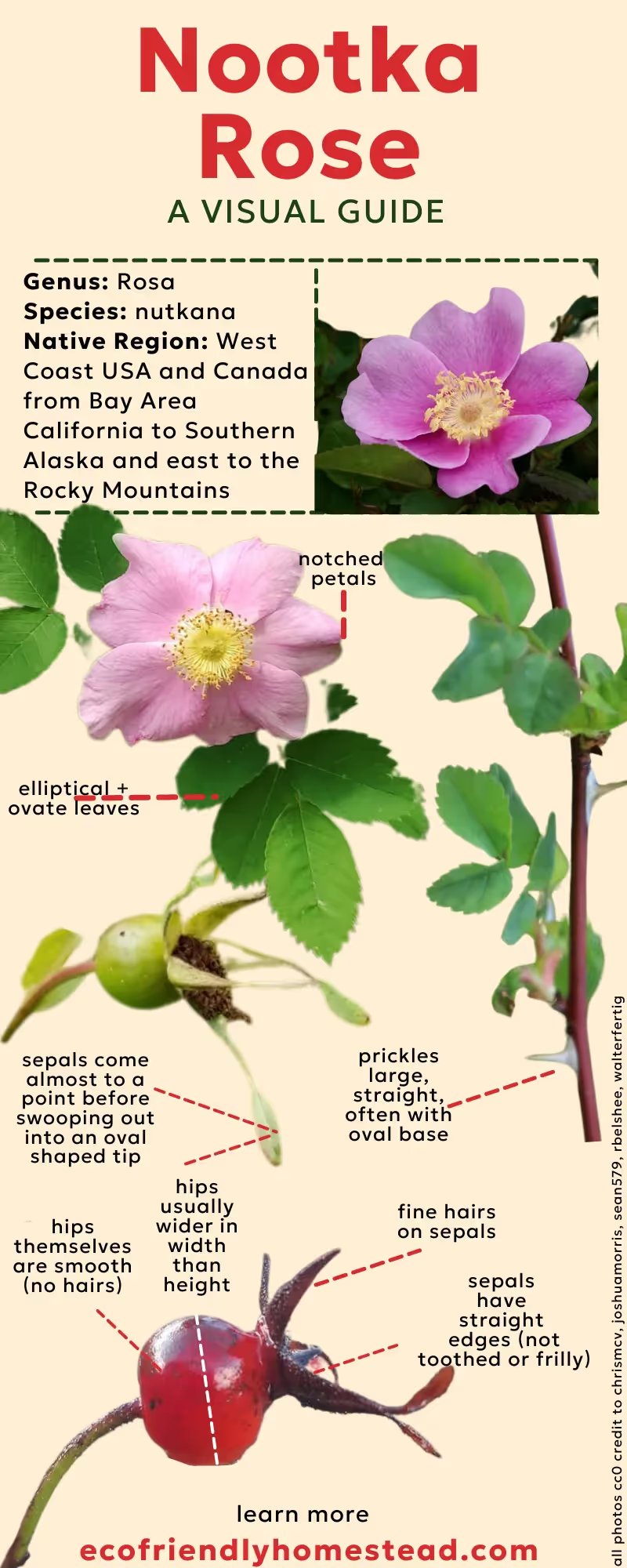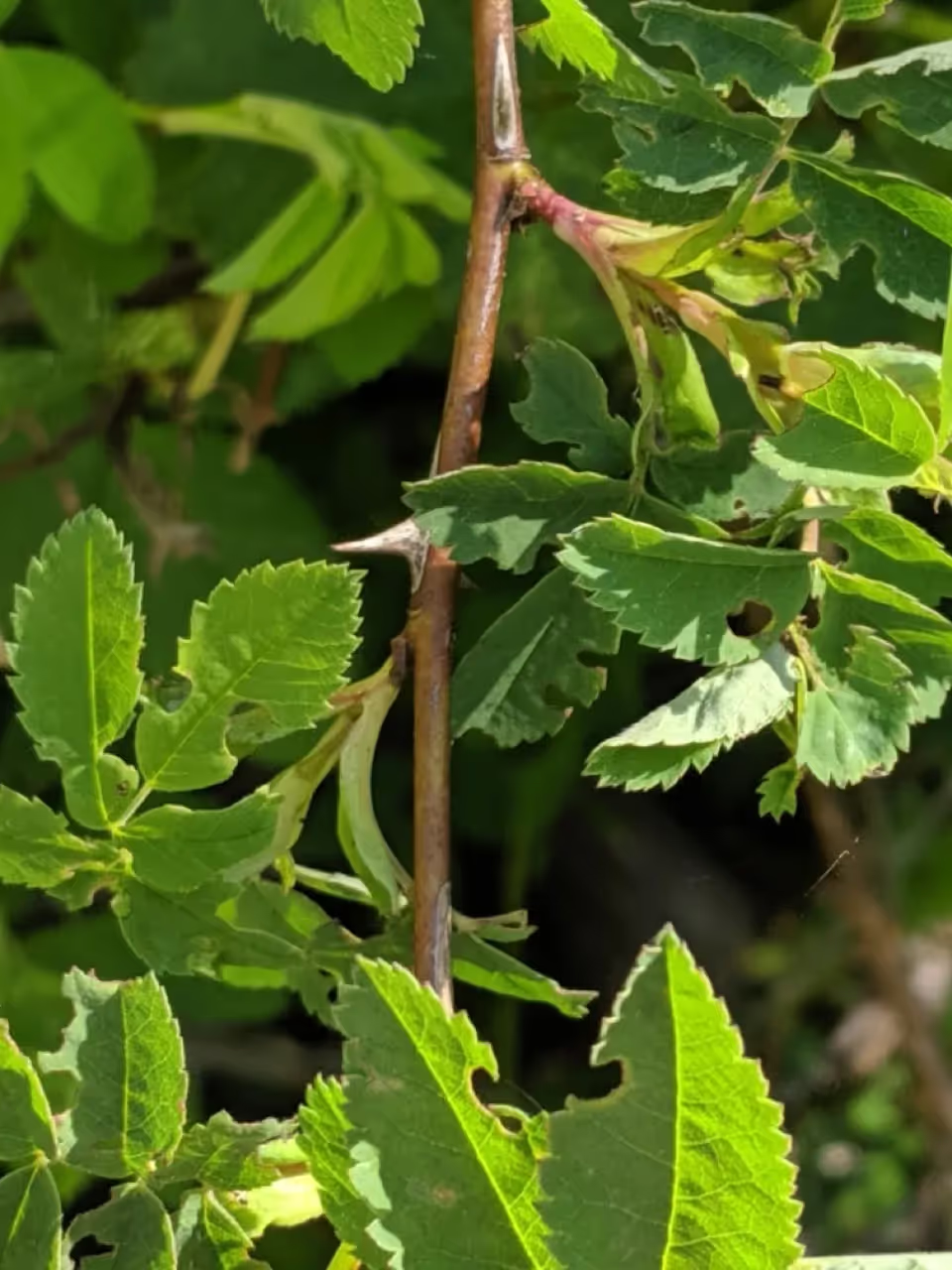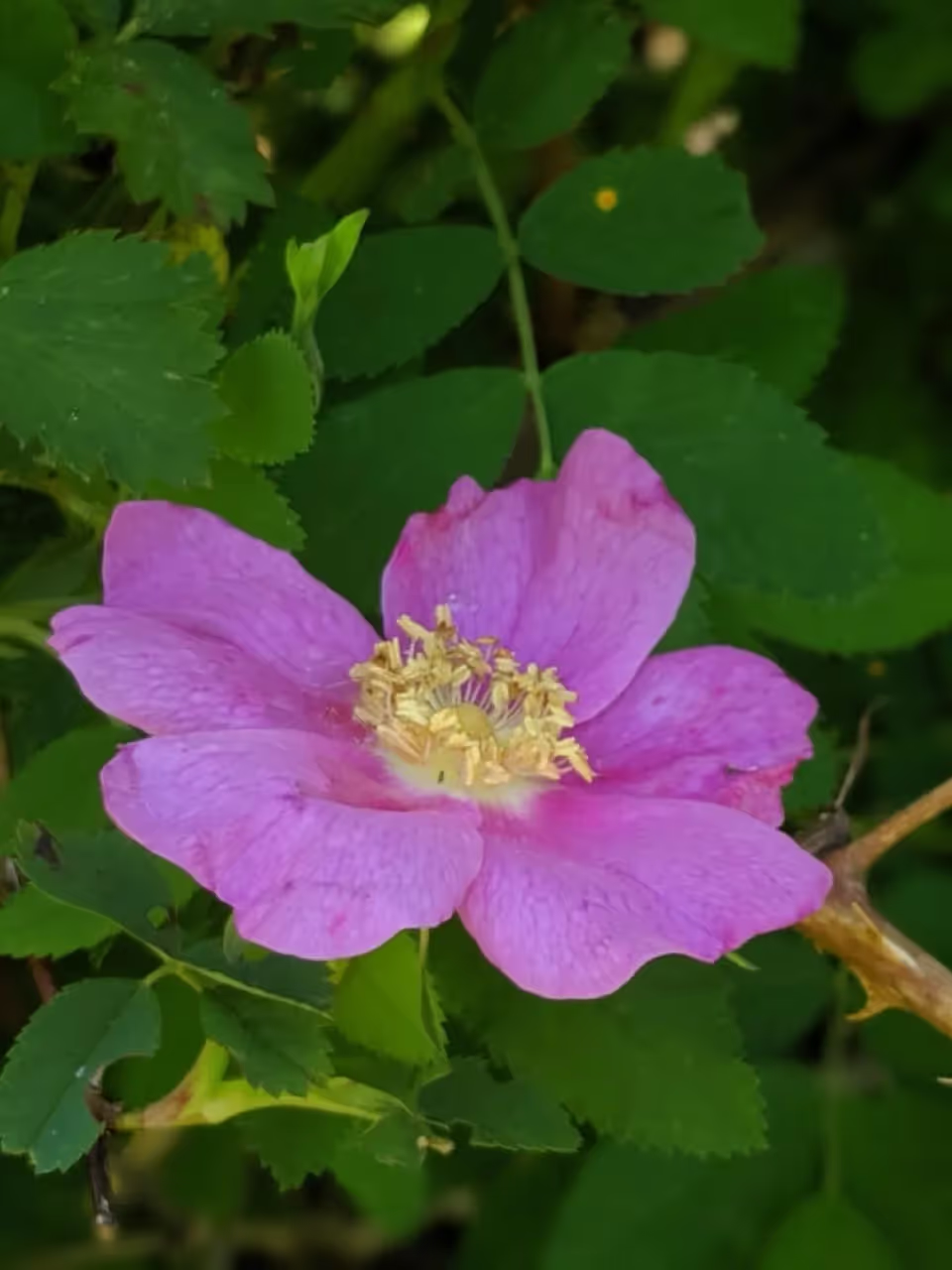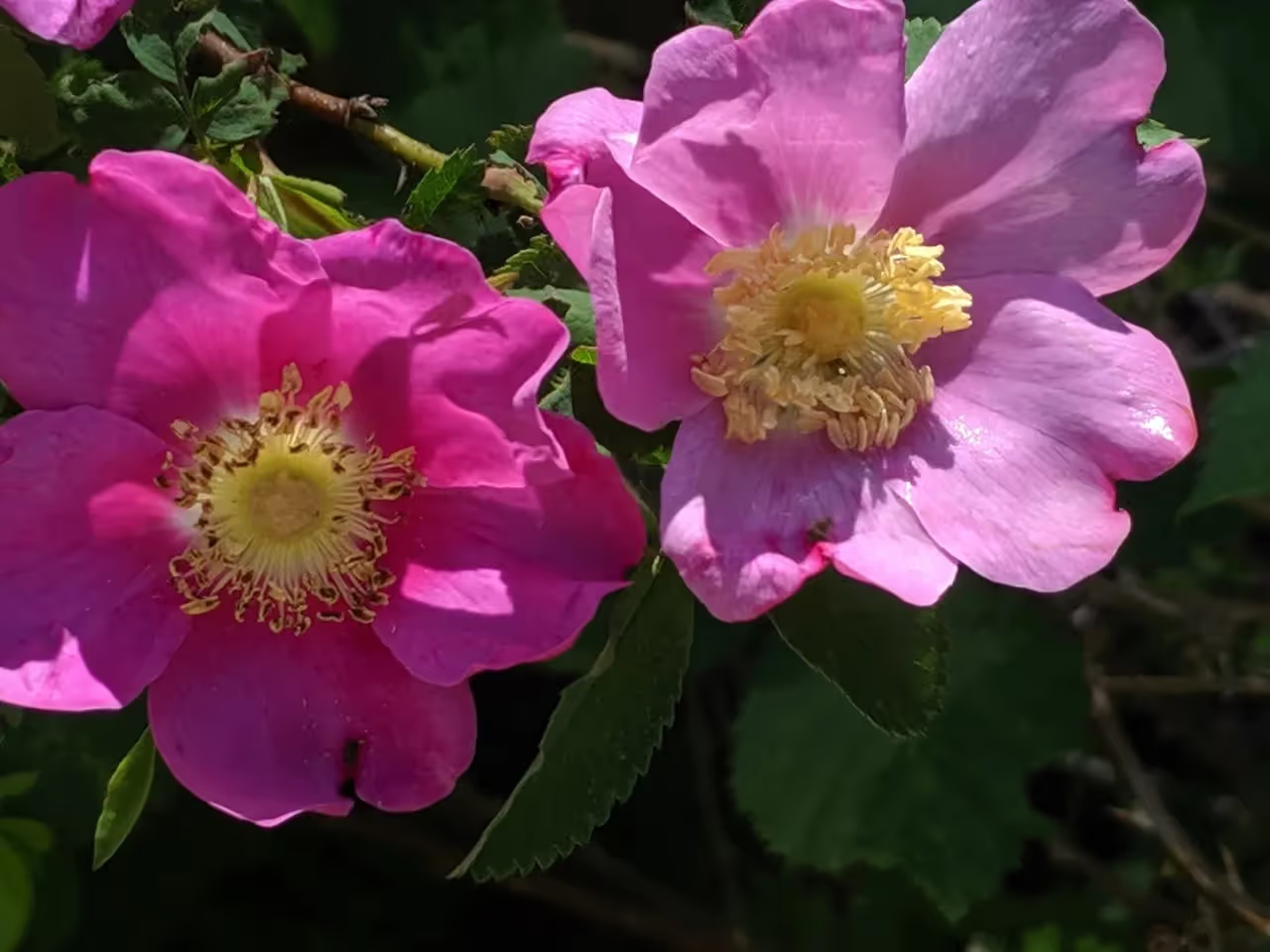
Be a Land Steward.
Sign up for Greenhouse Gases -
a weekly-ish newsletter that will teach you the science behind regenerative gardening, with action steps to help you make a difference in your backyard.

Sign up for Greenhouse Gases -
a weekly-ish newsletter that will teach you the science behind regenerative gardening, with action steps to help you make a difference in your backyard.

The Nootka Rose (Rosa nutkana) is as a symbol of resilience and ecological harmony in the Pacific Northwest. This guide delves into the specific traits and benefits of Nootka Rose, providing detailed insights to aid in its identification and conservation.
Nootka Rose is a wild perennial that adds beauty and biodiversity to the Pacific Northwest.
It’s a true example of a self-sufficient beauty.
The Nootka Rose proves that stunning blooms don’t always require meticulous care.
Instead, it’s the Nootka Rose who offers great care to the landscape. As a food source for a wide array of insects, beneficials, and wildlife, it’s a plant that gives back as much as it grows.
In this article, you’ll learn how this resilient plant adds beauty to your garden while also nourishing your local ecosystem.
This guide features high-quality visual keys with detailed ecological insights to give you a comprehensive and easy-to-understand guide to the Nootka Rose.
Botanical Name: Rosa nutkana
Common name: Nootka Rose
Native Region: West Coast through Rocky Mountains, ****British Columbia, Alaska
Growing Type: Perennial
Hardiness zone: 5-9
Major identifying characteristics:

Every year, I look forward to seeing the large blooms of Nootka rose transforming from bud to flower. It’s a true sign that summer has begun.
Have you come across the Nootka species in your yard or along a hiking trail? Here’s how to tell.
Location Characteristics:
❑ Found on forest edges or in part-shade.
❑ Prefers moist, well-drained soils.
Prickles Check:
❑ Large, straight prickles along the stem.
❑ Few prickles, usually in pairs below leaf node
❑ Curved prickles (near the Rockies).
Flower Characteristics:
❑ Large, solitary flowers.
❑ Five petals.
❑ Pink flowers with diameters ranging from 1.5 to 3 inches.
❑ Sepals have fine hairs on them, taper in the middle, oval shaped tip
Leaf Characteristics:
❑ Compound leaves with 5-7 leaflets.
❑ Double serrated edges with glandular tips (variety nutkana, west of the Cascades).
❑ Single serrations without glandular tips (variety hispidia, east of the Cascades).
Hip (Fruit) Characteristics:
❑ Large, deep redhips.
❑ Persistent sepals into winter.
Habitat Associations:
❑ Presence of associated plants like Douglas Fir, snowberry, etc.
Seasonal Timing:
❑ Bloom time (April-June).
❑ Hip formation (May-August).
❑ Hip maturity (August-September).

First, examine the thorns (technically, prickles). Are they mostly straight or curved like a dog's claw? If the prickles are predominantly straight and paired along the stem, you're one step closer to identifying your plant as a Nootka Rose, especially if you're in the PNW.
→ Closer to the Rockies, Nootka Rose does have curved thorns (Fieldguide).
→ Find a plant with hardly any prickles? That’s also characteristic of this species (WNPS).

Next, look at the flowers - or the buds or hips, for that matter. Are they in clusters of 3+ mostly, or are they generally single with some doubles scattered in? If it’s predominantly single, you’re on track to this being a Nootka. Don’t forget that wild roses (like Nootka) only have 5 petals.
Bonus: Nootka rose’s flowers are quite large for a wild rose in our area, from 1.5-3” in diameter.
(USDA FS, Backyard Habitats, Berkley, iNaturalist, UIdaho)
variety nutkana: west of the cascades, double serrations along leaflets, glands on the tips (NRCS)
variety hispidiais:east of the cascades to the Rockies, single serrations on leaves, no glands on the tips (NRCS)
variety melina: southern Rocky Mtns, curved prickles, under 5 feet tall, at 2500-3800 meters elevation (Lewis and Ertter)
Also if you see a rose that looks very similar to Nootka but has some odd characteristics, it could be a hybrid. Nootka can cross-breed with sweetbrier, cluster, wood, and baldhip rose (NRCS).
Nootka roses are generally found west of the Rockies, and prefer to be part of the understory of forest communities. However, it does not like to be in full shade as it needs sun to thrive. While it’s known for growing along forest edges, it also thrives in meadows, prairies, and pastures (OSU).
All of the patches of Nootka rose in my PNW yard are along the edges of woodland, usually among Douglas Fir groves, intermingled with blackberry and snowberry bushes, or hanging out with hawthorn or gooseberries.
An interesting commonality between all of these locations is that they’re in areas that are neighboring - but not in - wet soil.
The USDA Forest Service highlights these other plants to look for when searching for Nootka Rose:
Next time you're out hiking or wandering through a meadow, keep your eyes peeled for the gorgeous Nootka Rose!
Data from iNaturalist

April-June: Bloom time
May-August: Hip formation
August-September: Hip maturity
Fall + Winter: Hips are a food source for birds and mammals
The ecological role of Nootka Rose is fascinating. Beyond being a food source, it helps in soil stabilization and supports a variety of insect life.
Xerces, LBJWC, Wikipedia, USDA, Netarts
West of the Rockies, the Nootka Rose is well known by ecologists for its habitat restoration benefits. Its resiliency means that its likely to thrive in a variety of environments, and its speed of growth helps create ecosystem solutions fast (USDA).
This makes Nootka rose a great candidate for rehabilitating landscapes overrun by invasive species. In 2001 the Washington Dept. of Natural Resources selected the nutkana species of rose to help displace notoriously invasive knotweed along the Chehalis River.
Nootka rose is often selected to help with erosion control projects. This is because it has a spreading root system that holds back the soil on hills, streams, and disturbed areas (USDA).
For example, Rosa nutkana was selected to help prevent erosion at Piper’s Lagoon in Nanaimo, British Columbia. In 2020, the Green Shores Project successfully restored 458 square meters of a riparian area. Invasive species were replaced with native species, such as our featured rose. This helped to create a stable shoreline while also creating habitat for wildlife.
In areas where wildlife could benefit from extra support, Rosa nutkana comes into play as an integral part of hedgerow plantings. This helps create wildlife corridors to extend habitat.
Don’t feel like you need to work for the city or state to start nurturing your local landscape, though.
Take the lead from Mary Johnson, who lives in King County, Washington. She transformed her half-acre lawn into a beautiful habitat, full of native plants. Now, she shares her yard with reptiles, mammals, birds. And of course - pollinators abound!
Included in her success story is the Nootka Rose, intermingled in with snowberry and oceanspray.
Next time you're out exploring the meadows or forest edges of the Pacific Northwest, keep an eye out for the stunning Nootka Rose. Its beauty is matched only by its ecological significance.
Continue learning about native roses of the PNW with my full visual field guide here